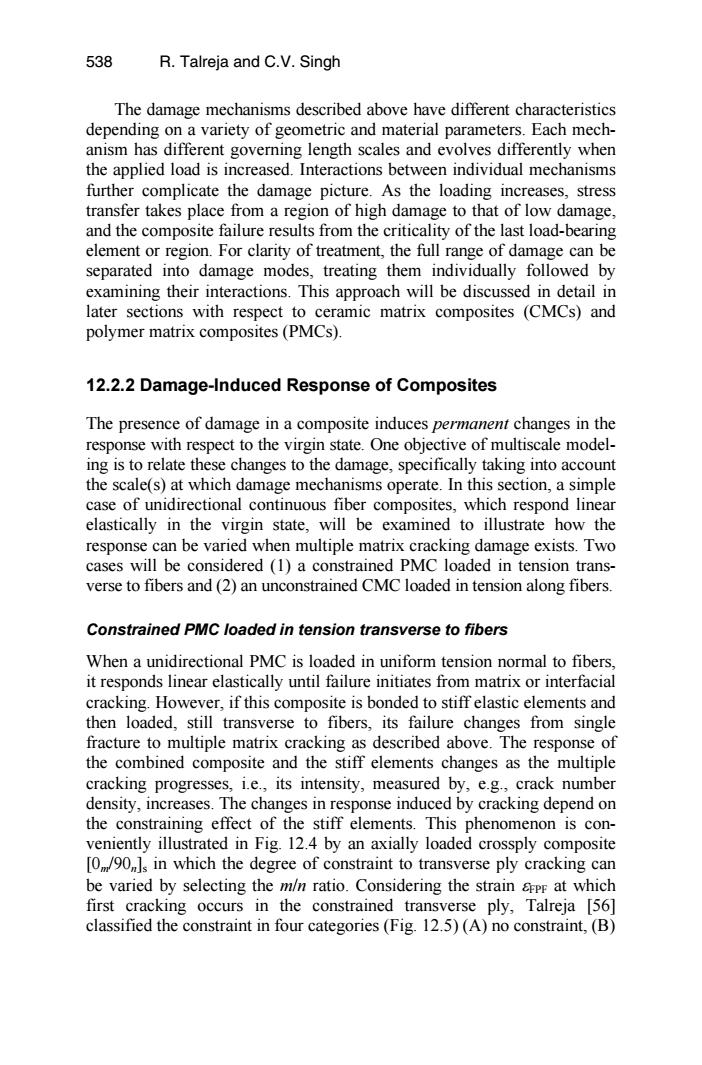正在加载图片...

538 R.Talreja and C.V.Singh The damage mechanisms described above have different characteristics depending on a variety of geometric and material parameters.Each mech- anism has different governing length scales and evolves differently when the applied load is increased.Interactions between individual mechanisms further complicate the damage picture.As the loading increases,stress transfer takes place from a region of high damage to that of low damage, and the composite failure results from the criticality of the last load-bearing element or region.For clarity of treatment,the full range of damage can be separated into damage modes,treating them individually followed by examining their interactions.This approach will be discussed in detail in later sections with respect to ceramic matrix composites (CMCs)and polymer matrix composites(PMCs). 12.2.2 Damage-Induced Response of Composites The presence of damage in a composite induces permanent changes in the response with respect to the virgin state.One objective of multiscale model- ing is to relate these changes to the damage,specifically taking into account the scale(s)at which damage mechanisms operate.In this section,a simple case of unidirectional continuous fiber composites,which respond linear elastically in the virgin state,will be examined to illustrate how the response can be varied when multiple matrix cracking damage exists.Two cases will be considered (1)a constrained PMC loaded in tension trans- verse to fibers and (2)an unconstrained CMC loaded in tension along fibers. Constrained PMC loaded in tension transverse to fibers When a unidirectional PMC is loaded in uniform tension normal to fibers. it responds linear elastically until failure initiates from matrix or interfacial cracking.However,if this composite is bonded to stiff elastic elements and then loaded,still transverse to fibers,its failure changes from single fracture to multiple matrix cracking as described above.The response of the combined composite and the stiff elements changes as the multiple cracking progresses,i.e.,its intensity,measured by,e.g.,crack number density,increases.The changes in response induced by cracking depend on the constraining effect of the stiff elements.This phenomenon is con- veniently illustrated in Fig.12.4 by an axially loaded crossply composite [O/90ls in which the degree of constraint to transverse ply cracking can be varied by selecting the m/n ratio.Considering the strain apr at which first cracking occurs in the constrained transverse ply,Talreja [56] classified the constraint in four categories (Fig.12.5)(A)no constraint,(B)The damage mechanisms described above have different characteristics depending on a variety of geometric and material parameters. Each mechanism has different governing length scales and evolves differently when the applied load is increased. Interactions between individual mechanisms further complicate the damage picture. As the loading increases, stress transfer takes place from a region of high damage to that of low damage, and the composite failure results from the criticality of the last load-bearing element or region. For clarity of treatment, the full range of damage can be separated into damage modes, treating them individually followed by examining their interactions. This approach will be discussed in detail in later sections with respect to ceramic matrix composites (CMCs) and polymer matrix composites (PMCs). 12.2.2 Damage-Induced Response of Composites The presence of damage in a composite induces permanent changes in the response with respect to the virgin state. One objective of multiscale modeling is to relate these changes to the damage, specifically taking into account the scale(s) at which damage mechanisms operate. In this section, a simple case of unidirectional continuous fiber composites, which respond linear elastically in the virgin state, will be examined to illustrate how the response can be varied when multiple matrix cracking damage exists. Two cases will be considered (1) a constrained PMC loaded in tension transverse to fibers and (2) an unconstrained CMC loaded in tension along fibers. Constrained PMC loaded in tension transverse to fibers When a unidirectional PMC is loaded in uniform tension normal to fibers, it responds linear elastically until failure initiates from matrix or interfacial cracking. However, if this composite is bonded to stiff elastic elements and then loaded, still transverse to fibers, its failure changes from single fracture to multiple matrix cracking as described above. The response of the combined composite and the stiff elements changes as the multiple cracking progresses, i.e., its intensity, measured by, e.g., crack number density, increases. The changes in response induced by cracking depend on the constraining effect of the stiff elements. This phenomenon is conveniently illustrated in Fig. 12.4 by an axially loaded crossply composite [0m/90n]s in which the degree of constraint to transverse ply cracking can be varied by selecting the m/n ratio. Considering the strain εFPF at which first cracking occurs in the constrained transverse ply, Talreja [56] classified the constraint in four categories (Fig. 12.5) (A) no constraint, (B) 538 R. Talreja and C.V. Singh